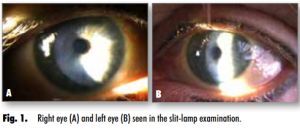PRACA ORYGINALNA
Cornea Verticillata – a Rare Complication of Chloroquine Toxicity. Case Report
1
Student Scientific Society The Eye, Departament of Ophthalmology, Medical University of Warsaw
2
Department of Ophthalmology, Medical University of Warsaw
3
SPKSO Ophthalmic University Hospital in Warsaw
Data nadesłania: 22-10-2023
Data akceptacji: 01-12-2023
Data publikacji: 29-12-2023
Ophthalmology 2023;(4):12-14
SŁOWA KLUCZOWE
STRESZCZENIE
Introduction: Cornea verticillata is characterized by bilateral grayish or golden-brown linear opacities in a typical vortex shape, mainly in the lower segments of the corneal epithelium, without covering the corneal stroma. It is most often associated with taking amiodarone but can be induced by other medications. Chloroquine is commonly used in treatment and prevention of protozoal diseases. Additionally, it has applications in dermatology and rheumatology as an anti-inflammatory agent in collagenosis, rheumatoid arthritis or lupus erythematosus. Its ophthalmic side effects and their management are noteworthy and are briefly summarized in this paper. Material and Methods: We present a case of a 62-year-old female patient who was referred to the clinic for diagnosis of corneal lesions detected incidentally during a follow-up examination 6 months after starting treatment with chloroquine for rheumatoid arthritis. Results: The patient was diagnosed with cornea verticillata and informed that it does not affect visual acuity and is not an indication for changes in therapy. Discontinuation of medication results in partial or, in some cases, complete resolution of changes. Discussion: It is important to closely monitor patients taking drugs that are known to have ophthalmic side effects for the first time in new indications. We should consider eye side effects when treating systemic disease and recommend screening tests. Conclusions: A baseline ophthalmic examination should be performed on all patients before initiating use of chloroquine. Moreover, chloroquine can lead to permanent loss of visual acuity contributing to bull’s eye maculopathy, which is irreversible.
Udostępnij
ARTYKUŁ POWIĄZANY
Przetwarzamy dane osobowe zbierane podczas odwiedzania serwisu. Realizacja funkcji pozyskiwania informacji o użytkownikach i ich zachowaniu odbywa się poprzez dobrowolnie wprowadzone w formularzach informacje oraz zapisywanie w urządzeniach końcowych plików cookies (tzw. ciasteczka). Dane, w tym pliki cookies, wykorzystywane są w celu realizacji usług, zapewnienia wygodnego korzystania ze strony oraz w celu monitorowania ruchu zgodnie z Polityką prywatności. Dane są także zbierane i przetwarzane przez narzędzie Google Analytics (więcej).
Możesz zmienić ustawienia cookies w swojej przeglądarce. Ograniczenie stosowania plików cookies w konfiguracji przeglądarki może wpłynąć na niektóre funkcjonalności dostępne na stronie.
Możesz zmienić ustawienia cookies w swojej przeglądarce. Ograniczenie stosowania plików cookies w konfiguracji przeglądarki może wpłynąć na niektóre funkcjonalności dostępne na stronie.




